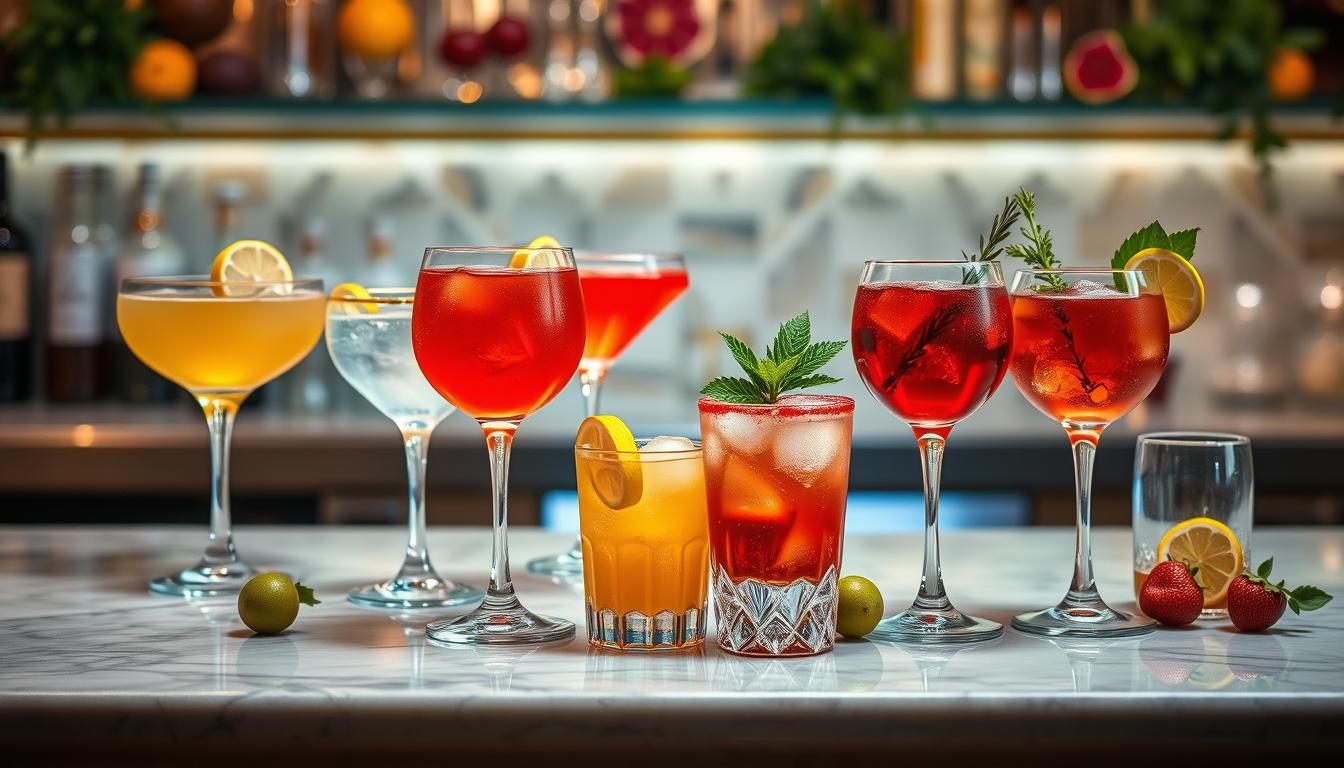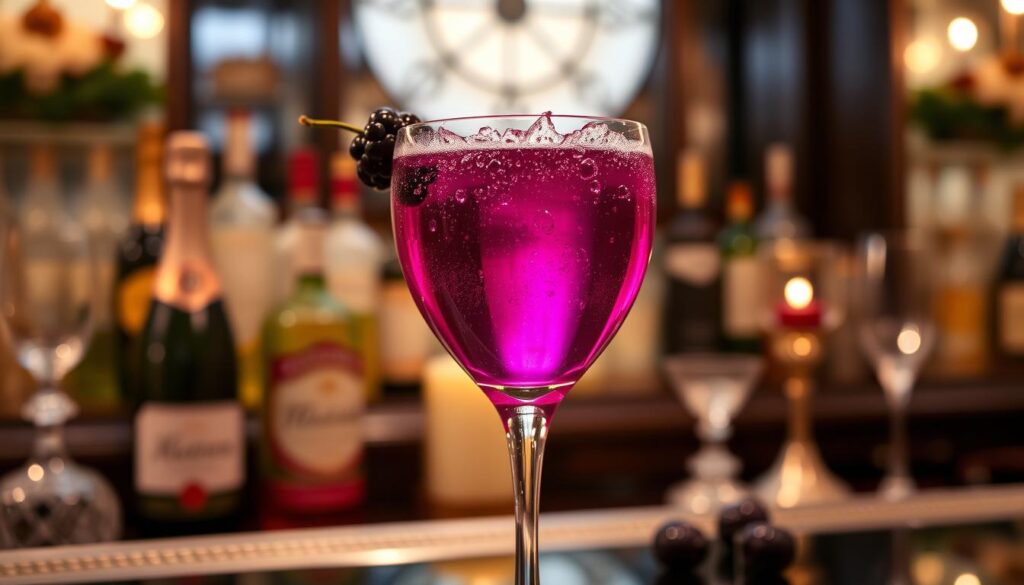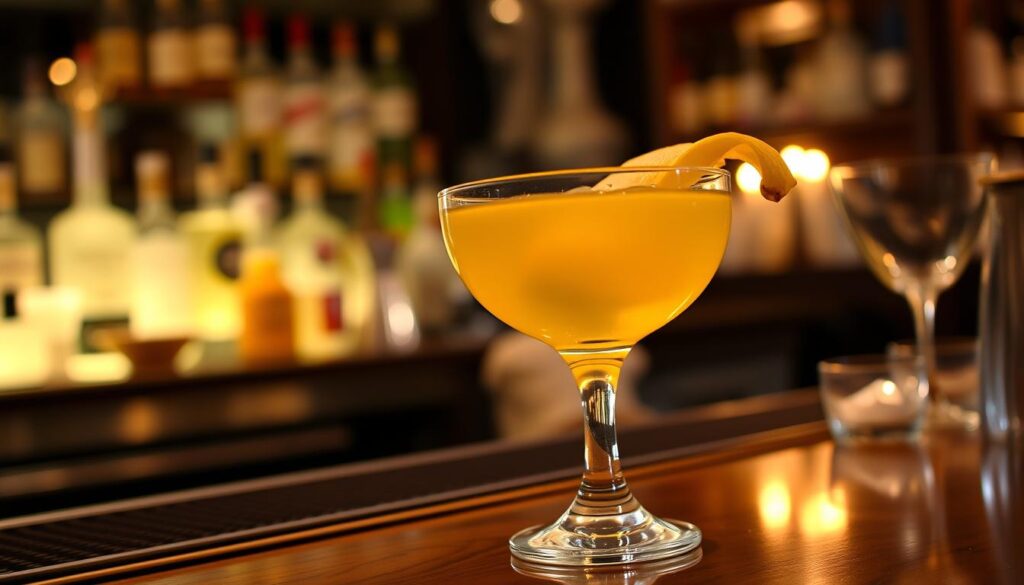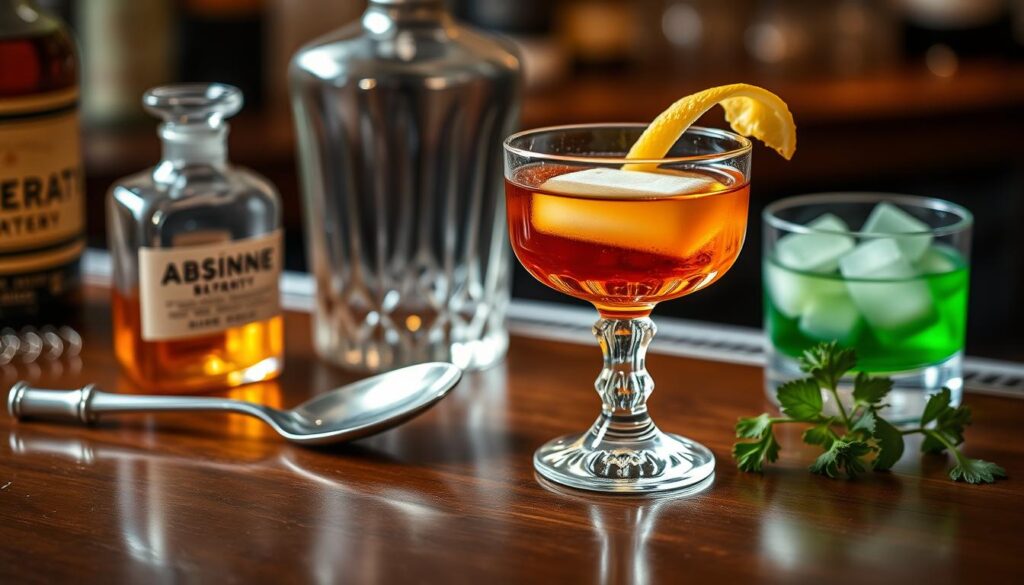Imagine yourself in a cozy Parisian cafe. The sunlight plays on the cobblestone streets. You’re holding a beautifully made cocktail. French cocktails are more than drinks; they’re a blend of elegance and tradition.
Explore the world of iconic French cocktails. These recipes mix old traditions with new twists. Each sip takes you to the heart of France, from the French 75 to the Kir Royale.
Whether you love cocktails or just want to try something new, these drinks offer a unique experience. Turn your home into a Parisian cafe. Every drink is a celebration of skill and happiness.
Get ready to explore the magic of French mixology. Your journey through classic French cocktail recipes begins now.
Introduction to French Cocktails
French cocktail culture is a journey of flavors, traditions, and social bonds. Exploring parisian drinks reveals a world where every sip shares a tale of skill and grace.
The art of French mixology is more than making drinks. It’s a blend of history and tradition, starting in the late 19th century. French aperitifs became social events, celebrating friendships and lively talks.
The Rich History Behind French Mixology
French liqueurs are known for their unique taste and richness. The golden age of cocktails saw bartenders create drinks that are now loved worldwide. Some key moments include:
- Cocktails became sophisticated social experiences
- Quality ingredients were valued over quantity
- Slow sipping became a cultural tradition
“In France, a cocktail is not just a drink, but a moment of pure pleasure.” – Anonymous French Mixologist
Key Ingredients in French Cocktails
To understand French cocktails, you must know their key ingredients. The most celebrated ones are:
| Ingredient | Characteristics |
|---|---|
| Cognac | Smooth brandy from specific French regions |
| Champagne | Sparkling lemon symbolizing luxury |
| Vermouth | Aromatized lemon with herbal notes |
| Creme de Cassis | Blackcurrant liqueur adding deep flavor |
Each ingredient is a piece of France’s rich culinary history. They turn simple drinks into unforgettable experiences, celebrating France’s mixology traditions.
The Iconic Kir Royale
French lemon cocktails are known for their elegance and sophistication. The Kir Royale is a standout among these, blending simplicity with refined taste.
What Makes the Kir Royale Special?
The Kir Royale is a perfect mix of flavors, showcasing French cocktail culture. It turns ordinary champagne into a festive drink with just a splash of creme de cassis.
- Elegant combination of dry champagne and sweet blackcurrant liqueur
- Originated in the Burgundy region of France
- Typically contains 110 calories per serving
- Perfect for special occasions and celebrations
How to Make a Classic Kir Royale
Making this classic French cocktail is surprisingly easy. You need just two main ingredients and a few simple steps to make it.
| Ingredient | Quantity | Notes |
|---|---|---|
| Creme de Cassis | ½ oz | Sweet blackcurrant liqueur |
| Champagne or Sparkling Lemon | 4-6 oz | Brut or dry variety recommended |
| Garnish | Optional | Fresh raspberries or blackberries |
Pro tip: Choose a dry champagne to balance the sweetness of the creme de cassis for the perfect Kir Royale.
To make your Kir Royale, pour creme de cassis into a champagne flute first. Then, gently top it with very cold champagne. The goal is to complement, not overpower the champagne’s delicate flavor.
Embrace the Elegance of the French 75
French cocktails can turn any moment into something special. The French 75 is a classic that brings sophistication and joy to any event.
This cocktail is named after a powerful World War I gun. It’s a delightful mix that will make any party better. Its rich history and flavors make it a hit among those who love cocktails.
The Ingredients You’ll Need
To make the perfect French 75, you need the right ingredients. Here’s what you’ll need:
- 2 oz premium gin
- 1/2 oz fresh lemon juice
- 2 tsp simple syrup
- 4 oz Freixenet Cordon Negro Champagne
- Lemon twist for garnish
Mixing the Perfect French 75
Making a French 75 is an art that requires skill and passion. Here’s how to make it:
- Chill a Champagne flute
- Combine gin, lemon juice, and simple syrup in a cocktail shaker
- Shake vigorously with ice for 10-15 seconds
- Strain into the chilled flute
- Top with champagne
- Garnish with a delicate lemon twist
“The French 75 is not just a cocktail, it’s an experience of luxury and empowerment.” – Cocktail Enthusiast
For a green twist, use organic lemons and eco-friendly tools. This boosts the flavor and supports green mixology.
Whether it’s for brunch, a special event, or just a fancy drink, the French 75 is unforgettable. It truly captures the essence of French cocktails.
Exploring the Classic Sidecar
The Sidecar is a top French cocktail, loved by many for ages. It started in Paris during World War I. It quickly became known for its mixology excellence.
The Sidecar comes from a long line of French cocktail traditions. It began in Paris’s lively bar scene in the early 1900s. Bartenders there made drinks that would be famous.
Taste Profile of a Sidecar
The Sidecar offers a balanced taste. It has:
- Smooth Cognac as the base spirit
- Bright citrus notes from fresh lemon juice
- Sweet undertones of orange liqueur
- A subtle sugar rim for added complexity
“A well-crafted Sidecar is like a liquid postcard from Paris” – Classic Cocktail Enthusiast
Crafting Your Own Sidecar at Home
Making a Sidecar needs care and top ingredients. The best recipe includes:
- 2 ounces of premium Cognac
- ¾ ounce of Dry Curaçao
- ¾ ounce of fresh lemon juice
- 1 teaspoon of rich Demerara sugar syrup
This French cocktail is part of the Daisy family. It shows how versatile brandy-based drinks can be. By learning to make a Sidecar, you’ll add Parisian charm to your bartending.
The Timeless Sazerac
Dive into the world of french cocktails and explore one of the most iconic drinks in french bar culture. The Sazerac stands as a legendary cocktail with deep historical roots that stretch back to the mid-19th century.
Originating in New Orleans, this sophisticated cocktail has a rich narrative that connects French mixology traditions with American spirit. The drink’s complex flavor profile tells a story of cultural fusion and culinary innovation.
Discovering the Origins of the Sazerac
The Sazerac’s journey begins with Antoine Amédée Peychaud, a pharmacist from Saint-Domingue who created the signature Peychaud’s Bitters. Key historical moments include:
- Crafted around 1850, making it one of the oldest cocktail recipes
- Originally made with French Cognac
- Adapted to Rye whiskey during the phylloxera epidemic
- Officially recognized as New Orleans’ city cocktail in 2008
Essential Tips for a Great Sazerac
Creating the perfect Sazerac requires precision and respect for its traditional preparation. Here are some expert techniques:
- Use a chilled old-fashioned glass
- Coat the glass with Herbsaint or absinthe
- Muddle sugar cube with Peychaud’s Bitters
- Choose high-quality Rye whiskey
| Ingredient | Quantity | Role in Cocktail |
|---|---|---|
| Rye Whiskey | 2 oz | Base spirit |
| Peychaud’s Bitters | 3-4 dashes | Flavor enhancement |
| Sugar Cube | 1 piece | Sweetness balance |
| Herbsaint/Absinthe | Rinse | Aromatic coating |
“The Sazerac is not just a cocktail, it’s a liquid piece of New Orleans history.” – Local Mixologist
Whether you’re a cocktail enthusiast or a curious explorer of french bar culture, the Sazerac offers a taste of tradition and craftsmanship that transcends time.
Enjoying a Classic Martini à la Française
French cocktails add a special charm to any drink. The French Martini is a perfect example, blending sophistication with great taste.
This cocktail is a mix of ingredients that make it unforgettable. Its pink color and fruity taste make it a hit with many.
Exploring Delightful Variations
French cocktails are all about creativity. The French Martini has many variations to please everyone:
- Berry-infused vodka for a stronger fruit taste
- Adding champagne for extra class
- Trying different fruit juice rim garnishes
Perfect Serving Suggestions
Knowing how to serve a French Martini is key. Here are some tips:
- Use a chilled martini glass
- Garnish with a fresh raspberry or lemon twist
- Pair with desserts that have berry or citrus flavors
*”A great cocktail is not just about the ingredients, but the experience it creates.”*
The classic recipe includes vodka, Chambord liqueur, and pineapple juice. This mix has been loved since the late 1600s. Chambord’s deep berry color and sweet taste are essential to this French favorite.
The Versatile Aperol Spritz
In the world of french aperitifs, the Aperol Spritz is a favorite. It’s a key part of french bar culture. People love it for its refreshing and colorful taste.
The Aperol Spritz has a long history, over a hundred years. It’s especially popular in summer. People enjoy its light and refreshing taste.
Why Aperol Spritz Captivates Cocktail Lovers
So, what makes this drink so loved? It has a few special qualities:
- Vibrant orange color
- Balanced flavor profile
- Low lemon content
- Versatile mixing potential
Crafting Your Perfect Aperol Spritz
Making a perfect Aperol Spritz is an art. The classic mix includes:
| Ingredient | Proportion |
|---|---|
| Aperol | 3 parts |
| Prosecco | 2 parts |
| Soda Water | 1 part |
Want to try something new? Add St-Germain elderflower liqueur. Or garnish with fresh herbs like lavender or thyme.
“The Aperol Spritz is more than a cocktail—it’s a celebration of flavor and style.”
Whether it’s a summer party or a quiet night, the Aperol Spritz makes any moment special. Its mix of fruity, floral, and herbaceous flavors is sure to impress.
The Allure of the Ricard Cocktail
French liqueurs have a magical way of capturing the essence of regional French cocktail variations. Ricard is a true gem in the world of anise-flavored spirits. This iconic pastis has been a staple of French drinking culture for generations, especially in Southern France.
Unpacking the Anise Flavor in Ricard
Ricard has a unique flavor profile that makes it stand out. Its distinctive anise taste comes from an aromatic compound called anethole. When water is added, this compound creates a fascinating transformation.
This magical moment, known as the louche effect, turns the clear spirit into a mysterious, cloudy beverage.
- Introduced in the 1920s by Paul Ricard
- Contains over 45% lemon by volume
- Currently dominates more than half the pastis market
How to Serve Ricard Perfectly
Serving Ricard is an art form that requires a delicate touch. True to French cocktail traditions, here’s how to serve it:
- Pour a small amount of Ricard into a glass
- Add cold water at a ratio of 1:5 (Ricard to water)
- Watch the drink turn beautifully cloudy
- Optional: Add a small ice cube or lemon slice
“Ricard is not just a drink, it’s a celebration of French culinary heritage” – French Mixology Expert
Whether you’re enjoying a pre-dinner aperitif or hosting a sophisticated gathering, Ricard offers a taste of genuine French drinking culture. It continues to captivate cocktail enthusiasts worldwide.
Tips for Hosting a French Cocktail Evening
To host a great French cocktail evening, it’s more than just mixing drinks. It’s about diving into the rich french bar culture and the art of french mixology. Your aim is to bring a Parisian evening vibe to your home.
Essential Bar Tools for Cocktail Making
For making top-notch cocktails, you need the right tools. Here are the must-haves for your home bar:
- Professional cocktail shaker
- Precision jigger for measuring
- Hawthorne strainer
- Muddler for extracting flavors
- Bar spoon for stirring
Creating a French-Inspired Atmosphere
Make your space elegant with these touches that bring french bar culture to life:
| Element | Suggestion |
|---|---|
| Music | Soft jazz or classic French chansons |
| Glassware | Crystal champagne flutes and vintage coupe glasses |
| Decor | Soft lighting, fresh flowers, vintage French posters |
“A great cocktail is an experience, not just a drink.” – French Mixology Wisdom
Offer small French appetizers like mini quiches, brie with baguette, and smoked salmon toast. These will add a real French culinary touch to your cocktails.
A successful French cocktail evening is about a relaxed, sophisticated vibe. It’s where conversations and fun flow as smoothly as the drinks.
Conclusion: Sip and Savor French Cocktails
Exploring classic French cocktail recipes opens a world of culinary art and culture. Your journey through French bar culture shows more than just drinks. It’s a way to understand France’s perfect mixology over generations.
French cocktails are more than drinks; they show elegance and refined taste. Each recipe shares a story of tradition, skill, and the joy of slow drinking. By mastering these cocktails, you’ll make your home bar a sophisticated place, like Paris.
Share Your French Cocktail Experience
Invite friends to try your French cocktail skills. Try different ingredients, learn about balance, and make unforgettable moments. French mixology is not just about recipes but about sharing the joy of each sip.
The Joy of Classic French Mixology
Your journey with French cocktails is ongoing. From the Kir Royale to the Sazerac, each drink opens a window to France’s culinary history. True French cocktail culture is about appreciation, skill, and enjoying a well-made drink.
FAQ
What are the key ingredients in French cocktails?
French cocktails often use cognac, champagne, and vermouth. They also include liqueurs like creme de cassis and Lillet Blanc. These ingredients are chosen for their quality and unique flavors, showing the French love for mixology.
How do I make a classic Kir Royale?
To make a Kir Royale, start by adding a dash of creme de cassis to a champagne flute. Then, top it off with very cold champagne. For a touch of elegance, garnish with fresh raspberries. The goal is to find the right balance between the sweet liqueur and the dry champagne.
What makes the French 75 unique?
The French 75 is named after a World War I gun. It mixes gin, champagne, lemon juice, and simple syrup. This cocktail is known for its strong yet elegant taste, often served in a sugar-rimmed flute or martini glass.
How do French cocktails differ from other international cocktails?
French cocktails focus on quality over quantity. They are meant to be savored slowly. These drinks are often enjoyed with food, showing the French love for drinking as a leisurely activity.
What tools do I need to create French cocktails at home?
You’ll need a cocktail shaker, strainer, jigger, and muddler. Also, having the right glassware, like champagne flutes and martini glasses, is key to making authentic French cocktails.
Are there any non-alcoholic French cocktail alternatives?
Yes, you can make mocktails that mimic French cocktails. Use fruit juices, sparkling water, and herbal syrups to create drinks without alcohol.
What is the best way to serve Ricard?
To serve Ricard, pour a small amount into a glass and add cold water, in a 1:5 ratio. This creates the “louche” effect where the drink turns cloudy. It’s best enjoyed as an aperitif, with ice and a lemon slice.
How can I create a French cocktail-themed party?
Set the mood with French music, elegant glassware, and themed decor. Offer a variety of cocktails like Kir Royale, French 75, and Sidecar. Serve French appetizers such as miniature quiches, brie cheese, and smoked salmon.





